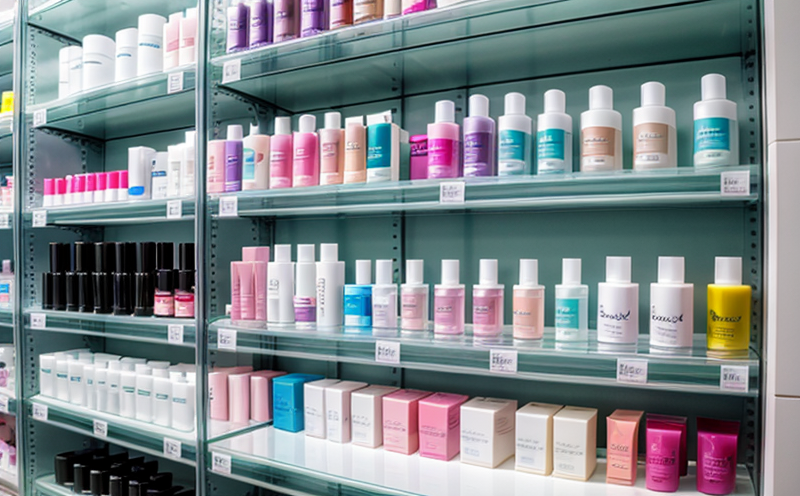Migration Testing of Packaging into Cosmetic Products
Migration testing is a critical aspect of ensuring product safety and compliance with international standards in the cosmetics sector. This process involves assessing whether harmful substances from packaging materials, such as containers or closures, can migrate into cosmetic products during storage and use. The primary goal is to prevent the introduction of toxic elements like heavy metals, plasticizers, or other potentially hazardous compounds that could adversely affect human health.
The testing protocol typically follows stringent guidelines outlined in international standards such as ISO 21978-3:2015 and ASTM D6401. These standards provide a framework for simulating real-world conditions under which migration might occur, including temperature, humidity, and exposure time. The samples tested are often formulated with actual cosmetic ingredients to simulate the final product's chemical composition accurately.
For instance, containers made of materials like polyethylene terephthalate (PET), high-density polyethylene (HDPE), or glass may be chosen for testing due to their widespread use in cosmetics. The testing apparatus used includes chambers capable of maintaining precise temperature and humidity levels over extended periods. After exposure, the samples are analyzed using analytical techniques such as gas chromatography-mass spectrometry (GC-MS) or inductively coupled plasma mass spectrometry (ICP-MS), depending on the type of compound being tested.
The results from these analyses determine whether any unacceptable levels of migration have occurred. If migration is detected, further investigation into the packaging material composition and formulation adjustments may be necessary to mitigate risks. This process ensures that consumers are protected against potential health hazards associated with prolonged contact with cosmetic products.
| Application | Description |
|---|---|
| Ensure Compliance with Regulations | Migration testing helps manufacturers comply with regulatory requirements like the EU Cosmetic Regulation (EC No 1223/2009). |
| Promote Safety for Consumers | By detecting harmful substances, migration testing ensures that cosmetic products are safe for use. |
| Enhance Product Quality | This testing improves product quality by identifying and rectifying issues early in the development process. |
| Increase Consumer Trust | A transparent approach to safety testing builds trust among consumers, enhancing brand reputation. |
| Facilitate Market Entry | Pas |
The importance of migration testing cannot be overstated. It plays a vital role in maintaining the integrity and safety of cosmetic products throughout their lifecycle, from manufacturing to end-use by consumers.
Benefits
Migration testing offers numerous advantages that are essential for maintaining high standards in the cosmetics industry:
- Promotes Consumer Safety: By ensuring that no harmful substances migrate from packaging into cosmetic products, migration testing protects consumers' health.
- Enhances Product Quality: This rigorous process helps identify and eliminate potential quality issues early in the product development cycle.
- Facilitates Regulatory Compliance: Adhering to international standards like ISO 21978-3:2015 ensures that products meet legal requirements and avoid costly rejections or recalls.
- Builds Consumer Trust: Transparent safety testing processes instill confidence in consumers, fostering brand loyalty and positive public perception.
- Expands Market Opportunities: Compliance with global regulations opens doors to international markets where stringent standards are enforced.
- Saves Costs: Early detection of issues through migration testing prevents costly rework or product recalls later in the development process.
In summary, migration testing is not just a regulatory requirement but also a proactive step towards ensuring product safety and maintaining brand integrity. It contributes significantly to both consumer protection and business success in the cosmetics industry.
Frequently Asked Questions
Quality and Reliability Assurance
Migration testing plays a pivotal role in quality and reliability assurance within the cosmetics industry. By identifying potential risks early, this process ensures that products meet not only regulatory standards but also exceed customer expectations regarding safety and performance.
The rigorous nature of migration testing ensures that all aspects of packaging are thoroughly evaluated for their compatibility with cosmetic products. This includes checking for any leachable substances or contaminants that could potentially affect the product's quality or pose a risk to users' health. The results from these tests provide valuable insights into improving future product formulations and enhancing overall reliability.
Moreover, adherence to international standards like ISO 21978-3:2015 not only guarantees compliance but also demonstrates a commitment to excellence in the industry. This approach fosters trust among consumers and strengthens brand reputation, ultimately contributing to long-term business success.





